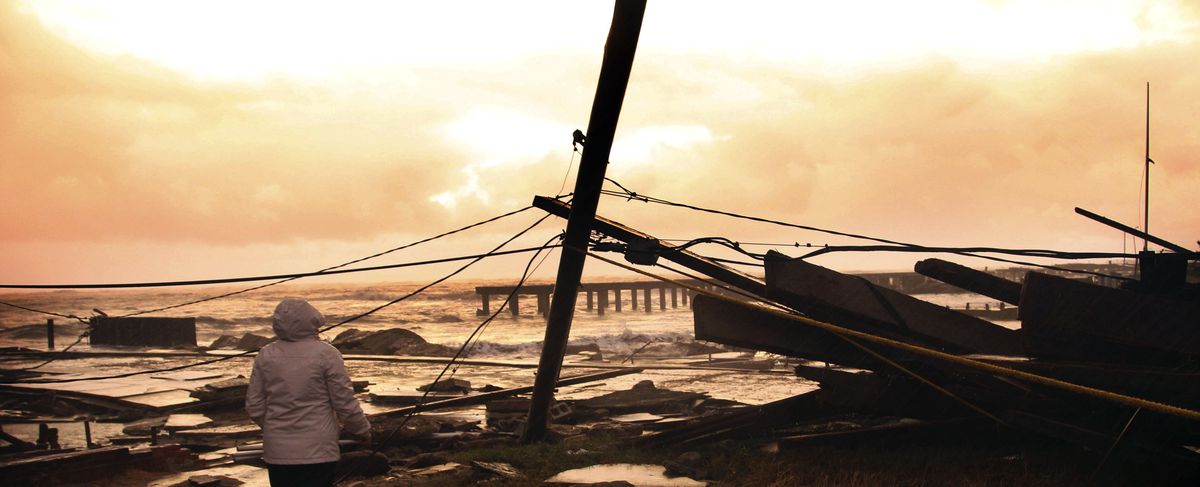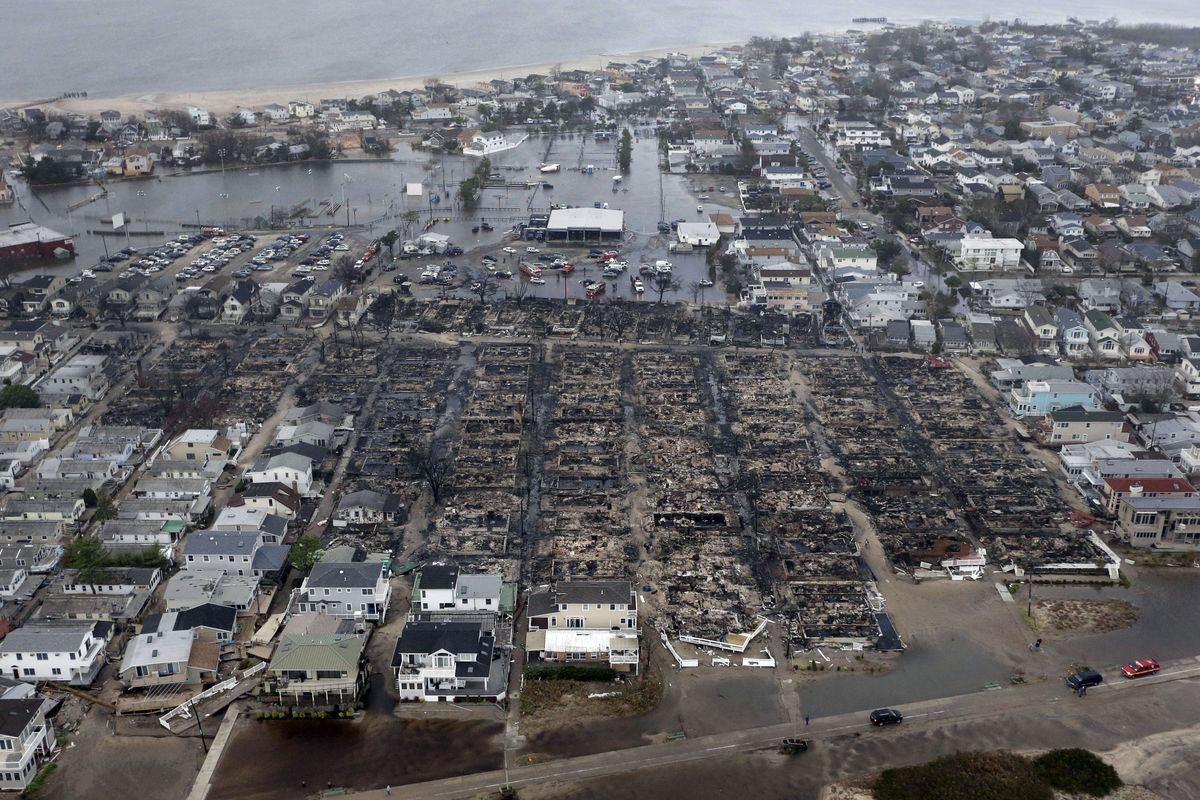‘Unthinkable’
Hardest part yet to come after Sandy pounds East
Kim Johnson looks over the destruction near her seaside apartment in Atlantic City, N.J., on Tuesday. (Associated Press)
BEACH HAVEN, N.J. – Sandy’s departure from the Northeast on Tuesday brought no hint of relief, revealing instead a tableau of splintered trees, severed beaches, shuttered businesses, and the harsh reality that the storm will test even the most hardened resolve in weeks to come.
The U.S. death toll rose to 50, including three children, and estimates of the property damage soared to $20 billion, which would make Sandy among the nation’s costliest natural disasters. More than 8 million homes and businesses in 17 states were without power, half of them in New York and New Jersey. Some outages could stretch into next week.
In the beach town of Breezy Point, N.Y., more than 80 homes were destroyed by a ferocious electrical fire that injured three people. All that remained of many homes were ashen foundations and concrete stoops that once led to front doors.
Inland, “thundersnow” blizzards buried more than half of West Virginia, where roofs of some houses began to collapse.
Near Hackensack, N.J., authorities launched a frantic rescue effort after a flood spilled over a riverbank, rose to the bottom of stop signs in less than an hour and trapped scores of people. Iconic pieces of the Jersey Shore, said Gov. Chris Christie, were “washed into the ocean.”
Pockets of New York City, particularly Manhattan, remained crippled. The subway system was flooded and closed for a second day.
By Tuesday afternoon, there were still only hints of the economic impact of the storm.
Forecasting firm IHS Global Insight predicted the storm will end up causing about $20 billion in damages and $10 billion to $30 billion in lost business. Another firm, AIR Worldwide, estimated losses up to $15 billion – big numbers probably offset by reconstruction and repairs that will contribute to longer-term growth.
“The biggest problem is not the first few days but the coming months,” said Alan Rubin, an expert in natural disaster recovery.
Authorities pledged an unprecedented recovery and relief effort. “No bureaucracy. No red tape,” said President Barack Obama, who called off a third day of campaigning for next week’s election.
Obama unlocked federal money for New York, New Jersey and Connecticut with a major-disaster declaration, skipping post-storm assessments and signing the paperwork even as the tail end of Sandy remained overhead. Christie asked Obama to speed up the declaration process “without all the normal FEMA mumbo-jumbo,” and the president agreed – finding the sufficient damage threshold self-evident, officials said.
U.S. Transportation Secretary Ray LaHood announced he had made $13 million in quick-release emergency funds available to New York and Rhode Island – the first two states that asked for it – to begin repairing roads, bridges and tunnels.
Camaraderie was apparent throughout the region. At a hospital in Manhattan, people formed a human chain to pass fuel up to the 13th floor, the only way to keep an emergency generator operating.
Power companies were working feverishly and in some cases – in suburban Pennsylvania, for example – had restored power to residences five days earlier than feared.
“Nature is an awful lot more powerful than we are,” said New York Mayor Michael Bloomberg. But he added: “We are on the road to recovery.”
Despite the unified front, some areas bordered on desperation.
Diane Vanderhorn, 46, hiked into Beach Haven, N.J., to learn the state of her little blue bungalow. Neighbors were coming out, dazed and carrying shopping bags full of clothes. “You been back yet?” one asked. Vanderhorn said she had not; the man shook his head and kept walking.
As she got closer, she saw trash cans rolling in the street, a boat grounded near an intersection. When she stepped inside, the rug squished under her feet. Sandy had flooded her home with seawater and filled her boyfriend’s black sedan to the dashboard.
“Oh my God! Oh my God!” Vanderhorn cried. “What am I going to do now?” She broke down in sobs. “I’ve got three kids. Where are we going to go? There’s no money.”
Christie, too, was overcome with emotion after viewing the waterfront damage. He saw submerged homes and boats piled on top of each other like toys and called the devastation “unthinkable.”
“I was just here walking this place this summer. The fact most of it is gone is just incredible,” he told the mayor of Belmar, N.J., Matt Doherty.
The misery will be extended by the blow Sandy delivered to the region’s infrastructure.
In New York, officials said the storm posed the greatest threat in the subway system’s 108 years. Flooding, they said, might have destroyed equipment, rail lines and power sources. The subway system, which ferries 5 million people a day, might not be running again until this weekend, officials said.
Thousands more flights scheduled for Tuesday and today were canceled, bringing the total to more than 18,000. That surpassed the 15,000 flights terminated by Hurricane Irene in August 2011. Some airlines had already begun to cancel Thursday flights.
Sandy began in the Atlantic and knocked around the Caribbean – killing nearly 70 people – and strengthened into a hurricane as it chugged across the southeastern coast of the United States. By Tuesday night it had ebbed in strength but was joining up with another, more wintry storm – an expected confluence of weather systems that earned it nicknames like “superstorm” and, on Halloween eve, “Frankenstorm.”
It became, pretty much everyone agreed Tuesday, the weather event of a lifetime – and one shared vigorously on social media by people in Sandy’s path who took eye-popping photographs as the storm blew through, then shared them with the world by the blue light of their smartphones.
On Twitter, Facebook and the photo-sharing service Instagram, people tried to connect, reassure relatives and make sense of what was happening – and, in many cases, work to authenticate reports of destruction and storm surges. They posted and passed around images and real-time updates at a dizzying rate, wishing each other well and gaping, virtually, at scenes of calamity moments after they unfolded. Among the top terms on Facebook through the night and well into Tuesday, according to the social network: “we are OK,” “made it” and “fine.”
By Tuesday evening, the remnants of Sandy were about 50 miles northeast of Pittsburgh, pushing westward with winds of 45 mph. It was expected to turn toward New York state and Canada during the night.
Although weakening as it goes, the storm will continue to bring heavy rain and flooding, said Daniel Brown of the National Hurricane Center in Miami.

